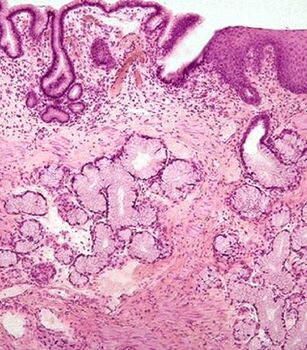
Esophageal injury and protection in physiologically animal models
O. Zayachkivska, I. Pshyk-Titko, N. Hrycevych, M. Savytska. New insight into oesophageal injury and protection in physiologically relevant animal models // Journal of physiology and pharmakology, 2014, 65, №2, Department of Physiology, Lviv National Medical University, Lviv, Ukraine.
Джерело: www.jpp.krakow.pl
Chronic diseases of lifestyle (CDL), the most common chronic group of non-infectious and non-transmissible diseases worldwide, which share the similar risk factors of unhealthy lifestyle, have become most recognized as a serious trigger in the genesis of oesophageal injury. Non-erosive oesophageal lesions (NEOL) are found more frequently than erosive or ulcer lesions in patients with reflux oesophagitis (RO) related to CDL. They also have restricted healing options, which often leads to carcinogenesis. Therefore, developing a physiologically relevant animal model of NEOL remains an urgent priority. One of triggers of CDL, postprandial hyperglycemia (PHG), which is characterized by hyperglycemic spikes, and overloading nitro-compounds leading to oxidative stress that may predispose to NEOL. The present study was designed to set up a model of RO related to CDL in rodents to understand mechanisms of oesophageal pre-ulcerogenic injury under such conditions as food-associated long-term PHG, restrained water-immersion stress (WIS), and imbalance of entero-salivary nitrites recirculation (ESNR). Beneficial effects of L-tryptophan (L-Try) have already been described by many activities in kynurenine and melatonin (Mel) synthesis, redox reactions, which play a key role for cytoprotection and proliferation. Nevertheless, the effect of L-Try and Mel on NEOL under PHG is still unknown. An extract of Cucurbita maxim sweet seed (eCMS), which contains a high amount of antioxidants, also appear to play an important role in foregut cytoprotection. Thus, the second aim was to observe the effects of eCSE on oesophageal mucosa (OEM) in modification of ESNR (mESNR). Rats were used with without/with pre-treatment L-Try, Mel during WIS and PHG. In the second series of experiments rats were used with without/with CSE pre-treatment in mESNR; oral and OEM lesions were determined by histology; inflammation of OEM by lectin histochemistry; esophageal NO2–, cNOS and iNOS via bioassays; interleukin 1β (IL-1β), interleukin-8 (IL-8) via ELISA. PHG caused destructive lesions in the OEM accompanied by the up-regulation of iNOS and down-regulation of cNOS expressions, excessive NO2– while COX significantly aggravated the severity of these lesions; L-Try prevented ulcerogenic response to PHG with potent up-regulation of cNOS but did not affect synthesis NO2–. Mannose (Man)-containing specific α-DMan glycoconjugates labelled by lectins GNA, PSL, LCA, ConA and fucose (Fuc)-rich Fuc-α1 glycoconjugates - PFA, LABA are contributed in OEM integrity. It was shown that the changes of subepithelial and epithelial structures labelled by GNA, PSL, LCA displayed their highest exposure in the surface layer, whereas in the intima of microvasculature and nerve fibres of serosa membrane of the oesophagus by ConA during PHG NEOL. Also, the overexpression of Fuc glycans was present in OEM pre-epithelial and epithelial layers labelled by LABA and in the epithelial-glial-endothelial activity by PFA. Thus, initial changes in endothelial metabolism via iNOS and eNOS can be diagnostic and prognostic markers of NEOL in RO. Our mESNR studies also documented an early increase in pro-inflammatory mediators in the initial stage of oesophageal ulcerogenesis and repair and it can be a model for both proximal and distal oesophageal reflux diseases, as determinate by NEOL in oral mucosa and OEM. These findings suggest that endothelial metabolism is deeply involved in pathogenesis of NEOL. These models may be useful for detecting a new therapeutic strategy NERD, testing anti-ulcer drugs against RO and impaired healing OEM. Our results suggest that L-Try and Mel prevent OEM damage inducted by PHG and oesophagoprotective effect via modulation NO/NOS activity. The anti-inflammatory effect of eCMS could be used to protect oral mucosa and OEM against mESNR.
Key words: oesophagus, animal model, postprandial hyperglycaemia, entero-salivary nitrites recirculation, L-tryptophan, Cucurbita Maxima sweet seed extract, nitric oxide, nitric oxide synthase, inflammation, interleukin-1β, GRO/CINC-1, mannose-, fucose-specific glycoconjugates.

Благодаря достижениям современной медицины коррекция таких особенностей вполне возможна. На выбор есть разные варианты, какие именно – читайте в статье.
Подробнее
Мечтаете о соблазнительных формах, но фигура далека от идеала? К сожалению, даже активные занятия спортом не всегда дают желаемый результат. В случаях, когда отдельным частям тела не хватает объема, п...
Подробнее
Парные органы крайне редко бывают полностью одинаковыми, поэтому незначительная разница в объеме, размере ареол, форме и высоте молочных желез случаются у многих женщин и являются вариантом нормы.
Подробнее


